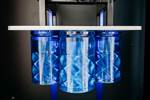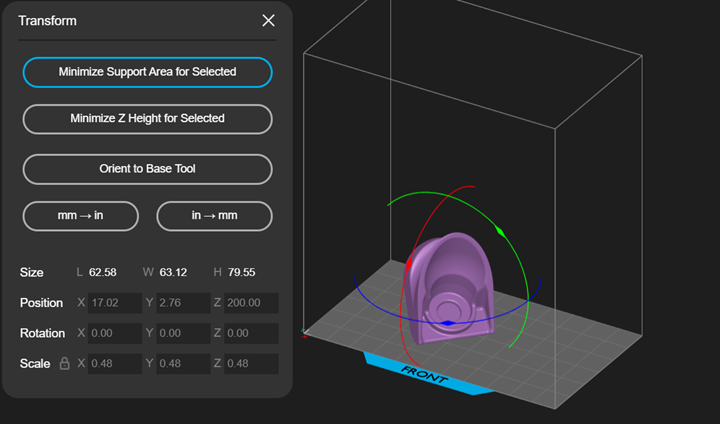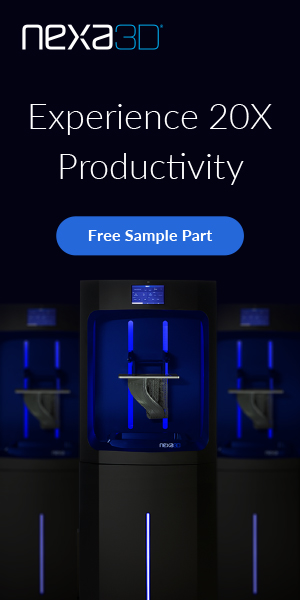How to Improve Polymer AM Productivity 20X
Sponsored ContentA fast cycle time is critical to efficient production 3D printing, but it’s not the only thing. How you choose the right parts for AM, prepare jobs for production, and manage post processing will have just as big an impact on total 3D printing throughput. It all needs to work together to achieve maximum productivity.
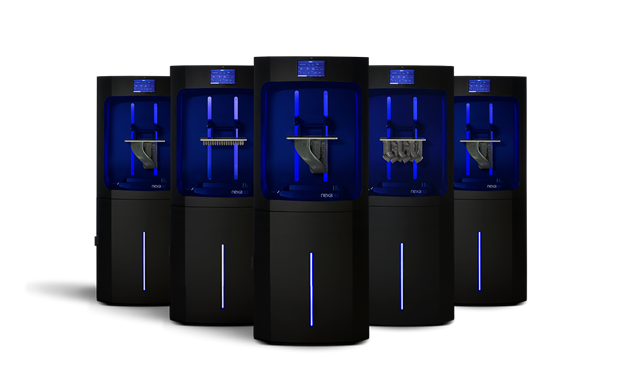
Nexa3D NXE 400 3D printers
Historically additive manufacturing (AM) has been limited to low-volume, high-cost or high-complexity parts. That’s been a barrier to wider adoption of AM in production, and for good reason. From a pure direct cost perspective, low build rates often result in equipment accounting for more than 50% of production cost. The effort and time invested in preparing jobs for AM and laborious post-processing requirements further narrow the window where additive manufacturing makes economic sense.
Nexa3D, an additive manufacturing solutions company, has an answer for this with a suite of technology that addresses every phase of the photopolymer additive manufacturing process. Yes, Nexa3D NXE 400 3D printers are fast. With higher speed printing coupled with a larger 16 liter (61 cubic inches) build chamber, Nexa3D says they can achieve print speeds as much as 6.5 times faster than comparable printers. But that’s a far cry from a claim of 20X improvements in productivity. Here’s the rest of the story.
AM Economics
The major cost components for AM are:
Capital Depreciation – This includes the 3D printer, but also any required post-processing equipment. The capital utilization rate is influenced directly by the speed and size of the printer which determine the number of parts that can be produced in a day.
Material Costs – Material costs for AM often require a different calculus than traditional manufacturing. Initial material cost may be more but yield is usually better with very little scrap. However, some AM processes have hidden material waste streams which may depend on the material characteristics, geometries produced and post-processing methods used.
Labor costs – AM labor includes file preparation, machine loading/unloading and post-processing. Labor costs depend heavily on equipment productivity, automation of both hardware and software, and the specific post-processing requirements of each part.
Improving AM productivity involves addressing each of these issues. For example, a quicker and more predictable process for preparing build routines reduces labor, gets jobs running faster, and can reduce the difficulty of meeting required quality standards. Faster printing and the ability to make more parts per build increases equipment utilization. The ability to print more accurately and predictably can dramatically reduce post-processing costs with more efficient support removal and possibly the elimination of secondary processes such as machining. It all adds up, and doing it all well is how dramatic improvements in 3D printing productivity can be achieved.
How Nexa3D Addresses Total AM Productivity
The ability to design and build more complicated parts is perhaps the most discussed economic benefit of AM with the ability to replace assemblies with a single printed part, and those cost benefits can be substantial. But selecting the right parts for AM and quickly getting those parts into an efficient production process is quite another matter. How you go about preparing the build routine is critical.

NexaX 2.0 is an AI-based software application that offers print preparation and 3D printer management.
It all begins with the AM software. Through the interplay of hardware, software and chemistry, NexaX 2.0 is an AI based software application that offers print preparation and 3D printer management. Along with API integration to other software, NexaX enables the realization of new properties for printed parts while enabling process stability, production scaling, consistent product quality, higher yields and excellent mechanical performance. It provides a variety of tools to aid total process efficiency such as quick file preparation, how to stack parts for maximum throughput, even how to place supports for easy removal.
With exceptionally fast proprietary slice algorithms and automatic support generation, NexaX software combines process and geometry algorithms with end-to-end workflows to optimize parts production. The software includes an extensive range of automation capabilities including:
- Automated file preparation
- Part rescale and duplication capability
- Automatic generation of optimal supports
- Lattice generation tools and mesh fixing
- Automatic part collision and out-of-bounds detection
- Accurate part print-time and resin consumption estimator
- Unique hollowing and perforation tools
- Remote management and live print view capability
Nexa3D NexaX automates build preparation with the ability to perform functions such as automatic support placement. Click to see full size image.
NexaX 2.0 software is also fully compatible with Ximplify™, Nexa3D’s automated 3D printing decision support portal which accelerates the ability of designers and manufacturers to adopt additive manufacturing at scale. Ximplify scans through material lists consisting of thousands of parts in minutes, selecting the ideal candidates for additive manufacturing. It determines the breakpoints where 3D printing can match or surpass the production cost of other process alternatives, and can make recommendations on when it is appropriate to work with service bureaus and when it’s time to bring production in house.
The software also includes seamless integration with Nexa3D’s large and growing materials portfolio, and can even suggest material alternatives for any given part. More on materials below.
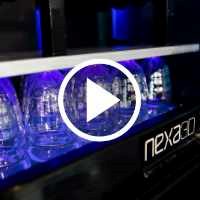
Watch: The Evolution of Resin 3D Printing to Ultrafast Production Manufacturing
Take a closer look at the recent advancement in both technology and materials that have propelled resin-based 3D printing to be a true contender for production applications.
Faster Printing
If you haven’t seen it, Nexa3Ds photopolymerization process is remarkably fast. It is based on LSPc technology (lubricant sublayer photo curing) which dramatically speeds the time it takes to move from layer to layer. SLA printers are “inverted,” meaning they print upside down, and they cure against a vat bottom or vat membrane. In the case of Nexa3D printers, light is projected up with channels and light guides to assure uniformity across build area. The light travels through an LED light mask where it gets finely pixelated to assure edge-to-edge part consistency and accuracy. Normally care must be taken to peel the part away from the vat, typically a slow and delicate operation. LSPc technology leverages a self-lubricated, flexible membrane that resists sticking to both the printed part and the underlying screen, which enables much faster printing speeds. To ensure process consistency a thermal management system is integrated to overcome the heat buildup from high-speed printing.
The technique enables vast improvements in cycle time and throughput. Since the speed of output is based solely on vertical height of the build, the total print time will be the same regardless of the number of parts you are printing. At top speed the process can achieve one vertical inch every 2½ minutes. Even at that speed the printer can achieve injection molded quality with sharp angles, smooth surfaces and perfectly round holes. Overall, the LSPc process enables production speeds that are up to 6.5x faster than other 3D printers from the same class.
Moreover, the Nexa3D 400 model includes a 16-leader build volume which is 2.5x greater than other SLA and DLP-based technologies. This allows for much larger parts, or more parts per build, with higher throughput, and ultimately lower part cost — all with higher-resolution pixels (76.5 µm) and isotropic prints.
Integrated Washing and Curing
Equally important to optimizing the entire photopolymer printing process is how you go about post-processing. Because of the accuracy and resolution of Nexa3D’s printing process, parts rarely need secondary finishing operations, such as machining. But parts will require washing and curing, and Nexa3D has developed integrated stations for efficient execution of these tasks, with the ability to accomplish both on the same baseplate platform.

xWash provides a fully adjustable cleaning cycle complete with preprogrammed cleaning recipes.
xWash is a washing station designed to work with Nexa3D printers that uses a proprietary washing agent optimized for 3D printing and sustainability. To move a part from printer to washing station you simply slide out the baseplate with part and slide it into the washer where it is processed automatically. The washer provides a fully adjustable cleaning cycle starting with preprogrammed cleaning recipes that enable the user to optimize cycles based on part geometry and material. This helps to achieve efficient and consistent cleaning for a variety of parts in minutes. To maximize throughput, it can accommodate two build plates simultaneously.
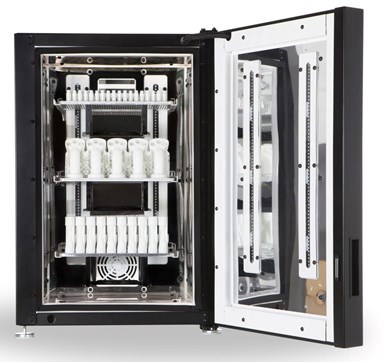
xCure is designed to consistently and rapidly assure desired photopolymer part properties at production quantities.
xCure is designed to consistently and rapidly assure desired photopolymer part properties at production quantities, part to part and printer to printer. It also comes with prescribed part processing menus that apply consistent process controls to achieve high dimensional accuracy and structural integrity regardless of part size or complexity. Like the washer, this unit is also sized as a companion to Nexa3D’s 400 series printer with capacity to cure up to three build plates at once or to place parts on translucent shelves to be cured individually.
The curing station uses high-power LEDs that operate at dual wavelengths, as well as sequential UV and thermal curing modes. It’s built to global industrial construction and safety standards and operates in three curing modes: UV only, heat only and UV+heat.
3D Printing Materials
The other critical component of a successful additive manufacturing operation is to identify and procure resins that meet the physical property requirements and processability standards appropriate for a given 3D printed part. To that end, Nexa3D has established collaborations with the world’s leading material suppliers including Henkel, BASF, Covestro, Evonik, and Arkema, to achieve the full potential of performance polymers tailored for faster, more economical design cycles for prototyping and for series production that consistently meets the same standards as functional prototypes.

Nexa3D has established collaborations with the world’s leading material suppliers including Henkel, BASF, Covestro, Evonik, and Arkema to develop application specific photopolymer resins.
These materials are tailored to the LSPc process to deliver high speed processing, durability and accuracy. Included among the current lineup of resins:
- xGPP-Translucent – Suitable for translucent, rigid, multipurpose high performance parts.
- xGPP-Gray – With excellent surface finish and true-to-design details, xGPP-Gray is ideal for texture rich models.
- xCE-White & xCE Black – High performance polymers for producing end-use plastic parts and injection molding tools.
- xABS Black – High performance, high modulus material with excellent flexural and tensile physical properties with a relatively high degree of elongation.
- xFlex – TPU like material that is ideal for printing grips, gaskets, seals, and prototypes for sportswear and footwear.
- xPeek – High-temperature resistant material with an HDT of 230°C. xPeek is great for tooling and other applications requiring high heat resistance.
As for picking materials, Nexa3D helps with its Ximplify automated 3D printing decision support portal. In addition to analyzing which parts are best suited to 3D printing, Ximplify will recommend the best printer and material to maximize performance and provide full part cost and return on investment analysis. The application will recommend materials for a part, taking into consideration the functional requirements and the processability of the material. Simply, it finds the fastest way to make the part you need. At the conclusion of each session, Ximplify generates an automatic report to support the entire decision making and implementation process.
Please visit the Nexa3D website for more information on Nexa3D printers and software.
